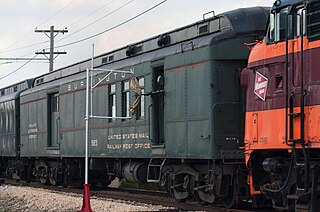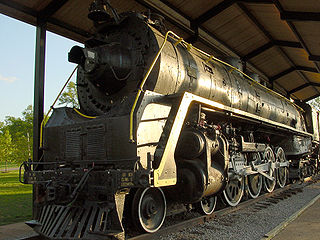
William Walton Kitchin was an American attorney and the 52nd governor of the U.S. state of North Carolina from 1909 to 1913.

In Canada and the United States, a railway post office, commonly abbreviated as RPO, was a railroad car that was normally operated in passenger service as a means to sort mail en route, in order to speed delivery. The RPO was staffed by highly trained Railway Mail Service postal clerks, and was off-limits to the passengers on the train. In the UK and Ireland, the equivalent term was travelling post office (TPO).

The Nashville, Chattanooga and St. Louis Railway was a railway company that operated in the U.S. states of Kentucky, Tennessee, Alabama, and Georgia. It began as the Nashville and Chattanooga Railroad, chartered in Nashville on December 11, 1845, built to 5 ft gauge and was the first railway to operate in the state of Tennessee. By the turn of the twentieth century, the NC&StL grew into one of the most important railway systems in the southern United States.

The Wreck of the Old 97 was an American rail disaster involving the Southern Railway mail train, officially known as the Fast Mail, while en route from Monroe, Virginia, to Spencer, North Carolina, on September 27, 1903. Travelling at an excessive speed in an attempt to maintain schedule, the train derailed at the Stillhouse Trestle near Danville, Virginia, where it careened off the side of the bridge, killing 11 on-board personnel and injuring seven others. The wreck inspired a famous railroad ballad, which was the focus of a copyright lawsuit and became seminal in the genre of country music.

The Norfolk Southern Railway was the final name of a railroad that ran from Norfolk, Virginia, southwest and west to Charlotte, North Carolina. It was acquired by the Southern Railway in 1974, which merged with the Norfolk and Western Railway in 1982 to form the current Norfolk Southern Railway.
The Augusta and Knoxville Railroad (A&K) was a railroad company that operated on 66 miles (106 km) of track between Augusta, Georgia, and Greenwood, South Carolina, from 1882 to 1886. It was merged with three other companies to form the Port Royal and Western Carolina Railway, which was reorganized in 1896 as the Charleston and Western Carolina Railway.

The East Bay Electric Lines were a unit of the Southern Pacific Railroad that operated electric interurban-type trains in the East Bay region of the San Francisco Bay Area. Beginning in 1862, the SP and its predecessors operated local steam-drawn ferry-train passenger service in the East Bay on an expanding system of lines, but in 1902 the Key System started a competing system of electric lines and ferries. The SP then drew up plans to expand and electrify its system of lines and this new service began in 1911. The trains served the cities of Berkeley, Albany, Emeryville, Oakland, Alameda, and San Leandro transporting commuters to and from the large Oakland Pier and SP Alameda Pier. A fleet of ferry boats ran between these piers and the docks of the Ferry Building on the San Francisco Embarcadero.
The Piedmont & Northern Railway was a heavy electric interurban company operating over two disconnected divisions in North and South Carolina. Tracks spanned 128 miles (206 km) total between the two segments, with the northern division running 24 miles (39 km) from Charlotte, to Gastonia, North Carolina, including a three-mile (5 km) spur to Belmont. The southern division main line ran 89 miles (143 km) from Greenwood to Spartanburg, South Carolina, with a 12 mi (19 km) spur to Anderson. Initially the railroad was electrified at 1500 volts DC, however, much of the electrification was abandoned when dieselisation was completed in 1954.
The Aberdeen and Asheboro Railroad (A&A), known locally as "Page's Road," was the conglomeration of two previous railroads built by the Page family of Aberdeen, North Carolina, at the turn of the 20th century. The railroad ran 56 miles (90 km) to connect its namesake cities with a 20.75-mile long (33.39 km) branch connecting Biscoe to Troy and Mount Gilead and another branch connecting West End to Jackson Springs.
The Fast Mail was a train service operated by the Chicago, Milwaukee, St. Paul and Pacific Railroad on an overnight schedule between Chicago, Illinois, and Minneapolis, Minnesota. The southbound trains were Milwaukee Road train Nos. 56 and 58, and the northbound trains were train Nos. 55 and 57. In its early years, this train service helped earn the Milwaukee Road's line the nickname "The Fast Mail Line." In 1924, the Fast Mail was the target of the largest train robbery in U.S. history. The Fast Mail was discontinued with train 56's arrival in Chicago on May 1, 1971.
The San Francisco and San Mateo Electric Railway (SF&SM) was the first electric streetcar company in San Francisco, California. The company was only in business for ten years, starting from 1892 until it was merged into the United Railroads of San Francisco (URR) in 1902.
Many railroads ran trains named Fast Mail, including:

The New Market train wreck happened when two Southern Railway passenger trains traveling at great speed collided head on near New Market, Tennessee, on Saturday, September 24, 1904, killing at least 56 passengers and crew and injuring 106.

Essex Fells was the terminus of the Erie Railroad's Caldwell Branch in the Essex County community of Essex Fells, New Jersey. Located at the junction of Oak Lane and Chestnut Lane in Essex Fells, the station was also a connection to the Morristown and Erie Railroad, which continued west through Roseland towards Morristown. The next station north from the Essex Fells station was Caldwell heading northward to Great Notch in Little Falls, where the line connected to the New York and Greenwood Lake Railroad.

The Los Angeles Pacific Railroad (1896−1911) (LAP) was an electric public transit and freight railway system in Los Angeles County, California. At its peak it had 230 miles (370 km) of track extending from Downtown Los Angeles to the Westside, Santa Monica, and the South Bay towns along Santa Monica Bay.

The Overland Limited was an American named passenger train which for much of its history was jointly operated by three railroads on the Overland Route between San Francisco and Chicago. The Southern Pacific Railroad handled the train west of Ogden, Utah, the Union Pacific Railroad between Ogden and Omaha, Nebraska/Council Bluffs, Iowa, and east of the Missouri River to Chicago it was operated by the Chicago and North Western Railway as well as, for a few years starting in 1955, by the Chicago, Milwaukee, St. Paul and Pacific Railroad.
The Lackawanna Limited wreck occurred when a Delaware, Lackawanna and Western Railroad (DL&W) passenger train, the New York-Buffalo Lackawanna Limited with 500 passengers, crashed into a freight train on August 30, 1943, killing 29 people in the small Steuben County community of Wayland in upstate New York, approximately 40 miles (64 km) south of Rochester.











